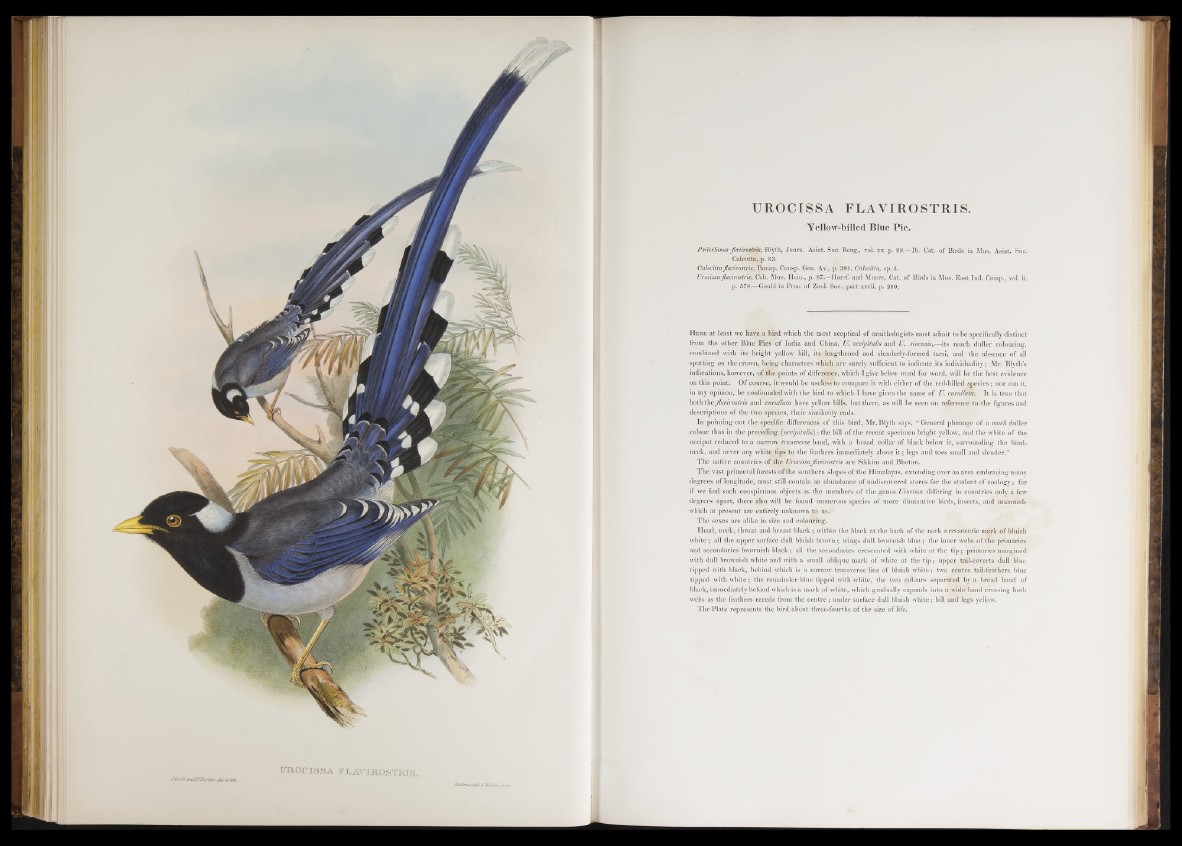
J.Geuld andKCIUchUr, d*L d fa J i.
UROCISSA FLAYIROSTRI S .
Yellow-billed Blue Pie.
Psilorhinus flavirostris, Blyth, Joum. Asiat. Soc. Beng., vol. xx. p. 28.—lb . Cat. of Birds in Mus. Asiat. Soc.
Calcutta£p. 93.
Calocitta flavirostris, Bonap. Consp. Gen. Av., p. 381, Calocitta, sp .3 .
Urocissa flavirostris, Cab. Mus. Hein., p. 87.—Horsf. and Moore, Cat. o f Birds in Mus. E ast Ind. Comp., vol. ii.
p. 578.—Gould in Proc. of Zool. Soc., p a r t xxvii. p. 200.
H e b e at least we have a bird which the most sceptical of ornithologists must admit to be specifically distinct
from the other Blue Pies of India and China, U. occipitalis and U sinensis?—its much duller colouring,
combined with its bright yellow bill, its lengthened and slenderly-formed tarsi, and the absence of all
spotting on the crown, being characters which are surely sufficient to indicate its individuality; Mr. Blyth’s
indications, however, of the points of difference, which I give below word for word, will be the best evidence
on this point. Of course, it would be useless to compare it with either of the red-billed species; nor can it,
in my opinion, be confounded with the bird to which I have given the name of U. cucullata. It is true that
both the flavirostris and cucullata have yellow bills, but there, as will be seen on reference to the figures and
descriptions of the two species, their similarity ends.
In pointing out the specific differences of this bird, Mr. Blyth says, “ General plumage of a much duller
colour than in the preceding (occipitalis) ; the bill of the recent specimen bright yellow, and the white of the
occiput reduced to a narrow transverse band, with a broad collar of black below it, surrounding the hind-
neck, and never any white, tips to the feathers immediately above i t ; legs and toes small and slender.”
The native countries o f the Urocissaflavirostris are Sikkim and Bhotan.
The vast primeeval forests of the southern slopes o f the Himalayas, extending over an area embracing many
degrees of longitude, must still contain an abundance of undiscovered stores for the student of zoology; for
if we find such conspicuous objects as the members of the genus Urocissa differing in countries only a few
degrees apart, there also will be found numerous species of more diminutive birds, insects, and mammals
which at present are entirely unknown to us.®
The sexes are alike in size and colouring.
Head, neck, throat and breast black ; within the black a t the back of the neck a crescentic mark of bluish
white; all the upper surface dull bluish brown; wings dull brownish b lu e ; the inner webs of the primaries
and secondaries brownish black; all the secondaries crescented with white at the t ip ; primaries margined
with dull brownish white and with a small oblique mark of white at the t ip ; upper tail-coverts dull blue
tipped with black, behind which is a narrow transverse line of bluish white; two centre tail-feathers blue
tipped with white; the remainder blue tipped with white, the two colours separated by a broad band of
black, immediately behind which is a mark of white, which gradually expands into a wide band crossing both
webs as the feathers recede from the c e n tre ; under surface dull bluish white; bill and legs yellow.
The Plate represents the bird about three-fourths o f the size of life.